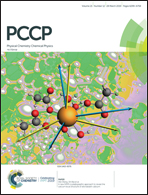Computational analysis of non-heme iron–oxo formation by direct NO release in nitrite reduction†
Abstract
A direct NO-releasing reaction of nitrite catalyzed by [N(afaCy)3Fe(OTf)]+ (afa (azafulvene-amine); OTf (trifluoromethanesulfonate); Cy (cyclohexyl)) was investigated using density functional theory (DFT) with D3 dispersion correction. The complex featured a secondary coordination sphere that facilitated the formation of the iron–oxo product [N(afaCy)3FeO]+ with three (Fe)O⋯H–N hydrogen bonds. As a high-spin iron(II), the O-binding initial intermediate Fe(O)–nitrito was thermodynamically favorable in the S = 2 state. The cleavage of the (Fe)O–NO bond was performed by a β-electron shift to produce Fe(III)–O by electron rearrangement in the S = 5/2 state. The different electron configurations are responsible for the structural properties, the valence of iron in the complexes, and the pathways of the reactions. Moreover, the two different H-bonds, (Fe)O⋯H–N and (Fe)O–H⋯N (by O-protonation), in the product complexes played a role in determining the reaction channels by impacting the N–H bond rotation. Thus, an exothermic sequence of conversions Fe(II) → Fe(III)–O → Fe(III)–OH → Fe(III)–O was established for the targeted product formation. This process provided a clue to build two key intermediates, iron–oxo and iron–hydroxo, in a variety of biological and synthetic systems. The results of this study are in agreement with experimental observations and describe the roles of H-bonding in nitrite reduction catalyzed by the non-heme iron complex.



 Please wait while we load your content...
Please wait while we load your content...